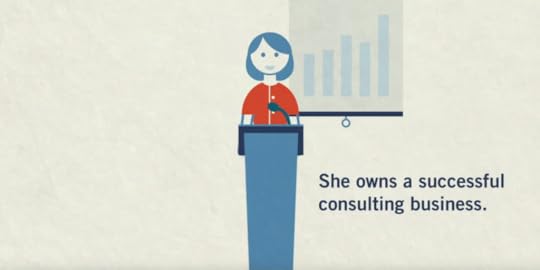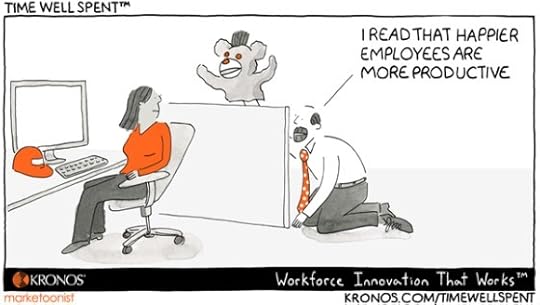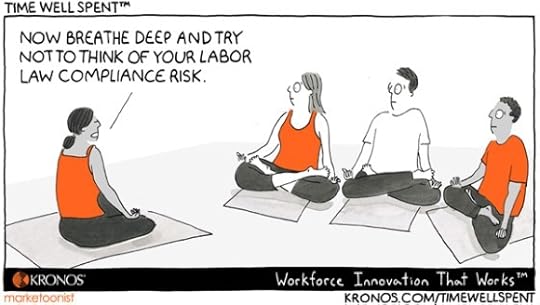Sharlyn J. Lauby's Blog, page 140
March 24, 2017
How to Make Your Employees Happy – Friday Distraction
(Editor’s Note: Today’s post is brought to you by our friends at Kronos , a leading provider of workforce management and human capital management cloud solutions. They were named one of the by the Great Place to Work Institute. Many congrats! Enjoy the post.)
We spend a lot of time talking about employee engagement and that’s not a bad thing. Employee engagement impacts productivity and the bottom-line. But let’s forget employee engagement for just a moment.
Does your organization know what makes employees happy? Today’s Time Well Spent from our friends at Kronos reminds me that employees are not going to become engaged if they aren’t happy about their work.
Organizations need to figure out what makes their employees happy. We’re not talking about the occasional bad day. That happens to everyone. Or the one part of our job we don’t like. That too happens to all of us. But managers should take the time to find out what they can do to make employees happy about their work.
Ask them! During the next one-on-one meeting with an employee, ask them “Besides a pay increase, what’s one thing that I can do to make you happier at your job?” Managers could tell employees ahead of time that they’re going to ask the question. Give employees time to think about it. Just remember, if you ask the question, be prepared to deal with the answer.
Initially focus on low-cost, no-cost. There’s a time and place to address big issues like compensation and benefits. I’m not ignoring that. But there’s also a lot of “low hanging fruit” that would make employees very happy. Start with things like reconfiguring office space for better flow, better office equipment and supplies, and a few luxuries in the breakroom. Then move to the bigger items.
Look for trends. Managers will want to pay attention to any trends they hear in employee responses. If six employees say that they would love a new office chair, there might be some workspace issues to research. Employees are productive when they have a comfortable workspace with good flow. It’s important not only to address the symptom but what could be a bigger problem.
Here's the simple answer to making your employees happyClick To Tweet
Organizations need to consider what makes employees happy in the workplace. Often, it starts with the little things. The good news is we don’t have to read employee’s minds. We can simply ask them.
The post How to Make Your Employees Happy – Friday Distraction appeared first on hr bartender.






March 23, 2017
Job References Are Out of Date – Ask #HR Bartender
When it comes to providing job references, I’m a bit torn. I know a lot of companies still ask for them. On the other hand, I’ve always thought that your references will all say that you’re perfect, so why bother? But after receiving today’s reader note, maybe I need to rethink my position.
Hello! I’m in the middle of interviewing for an upper-level research technician position and I’ve discovered that my reference list is out of date. I’m uncertain who to contact in this matter. I don’t want to contact the wrong HR person and be disqualified. Who is the best person to contact?
Regardless of your personal opinion about references, if you’re looking for a job, you should have your references ready. There are still plenty of companies that ask for references. Let me toss out a few things to consider in putting together your reference list.
References should be people you’ve worked with. I’m going to define “work” a little loosely here, because I do believe that you can use people you’ve worked with on large scale volunteer projects as references. When I was a part of HR Florida, we had a $1M budget. Those who volunteered on the conference team were working with budgets in the hundreds of thousands. They should be able to use that experience to demonstrate their skills. And their HR Florida colleagues would be ideal references.
Keep your job references current. There are several aspects to keeping references current. References from today are better than references from a decade ago. Stay in touch with references so you have their most current contact information. When you start interviewing, let your references know so they can support you. And absolutely, positively tell your references whenever you give their name to a prospective employer. You might not know exactly who is going to call, but at least give them the company’s name.
Clarify any mistakes in job reference contact info. I’ve actually had this happen. One of my references changed her cell phone number after I had given it to a recruiter. So, I called the recruiter and explained the situation. It wasn’t a big deal and it was only one phone number. I’m not sure in the situation above how much of the reader’s reference list is out of date and if there’s a logical explanation for the situation. Only the reader knows. But I’d like to believe that employers are reasonable. Even when we do all the right things, sometimes contact info needs to be updated.
The people you ask to be your job references should know your strengths and be willing to talk about them. They should be open to having their contact information provided to companies and receiving calls about you. The better job seekers are about managing their job references, the more they can help you get a job. And that’s the whole point of having references in the first place.
Image captured by Sharlyn Lauby while touring the National Atomic Testing Museum in Las Vegas, NV
The post Job References Are Out of Date – Ask #HR Bartender appeared first on hr bartender.






March 21, 2017
10 Strategies for Recruiting In a Highly Competitive Job Market
(Editor’s Note: Today’s post is brought to you by Alongside , a company that bridges the communication gaps to create a better hiring experience for both employers and job seekers. Check out they help companies like Motörleaf showcase their team dynamic to active and passive candidates. For a free trial or demo of their product , visit their website. Enjoy the post!)
We continue to hear how recruiting is a challenge. In a research report published last year by the Society for Human Resource Management (SHRM), sixty-eight percent (68%) of HR professionals are experiencing difficulty recruiting candidates. There are several reasons for the increased difficulty including skills gaps and lack of experience. However, forty-nine percent (49%) of HR pros cited competition from other employers as part of the challenge.
I feel like l’ve always worked in highly competitive environments. My thought is there are two different kinds of competition:
Industry-based is specific to a type of work, like the competition for tech talent in Silicon Valley. It could be based on a highly technical position. Or it could be the result of a geographic region becoming a hub for certain types of businesses.
General competition applies to all jobs, and is the result of low unemployment, increased voluntary quits, etc. It could also be the result of a geographic region getting a large employer and creating lots of jobs. Another reason could be a skills gap in a much-needed area like supervisory skills or critical thinking.
Organizations are not immune to competition and must be prepared to address both types. And, the answer isn’t poaching employees. It’s taking steps to make your organization rises above the competition.
10 Activities Your Organization Can Do to Recruit More Effectively Against the Competition
Build a solid employment brand. It starts with understanding what makes your organization unique. If your recruiting team doesn’t know, how will they sell candidates on the value of coming to work for the company. Make a concerted effort to find out why employees stay. Hiring managers could make this a “stay interview” question during their one-on-one meetings.
Be a great employer. Don’t hesitate to apply for a local/state/national “best places to work” award. It’s a great way to promote your organization and culture. Also, consider allowing the HR team to present at conferences. Not only is it great professional development for HR but they are sharing the company’s best practices.
Have a competitive compensation and benefits package. I realize a lot goes into the conversation about employee compensation and benefits. But the reality is, as the job market gets more competitive, so do compensation and benefits. Organizations need to ensure their packages are internally fair and externally competitive.
Have a good employee referral program. Employee referrals continue to be the most cost effective source of quality applicant flow. If the company is offering a bonus for recommending candidates, make sure it’s appropriate given your cost per hire. And consider adding alumni and contingent workers – both in terms of being referred and providing referrals. They’re a key piece to today’s recruiting strategy.
Give candidates a realistic job preview. Job seekers are doing their homework before applying with a company. Organizations should develop a career portal where active and passive job seekers can see a typical “day in the life” of an employee. This can be done with video and using employee testimonials. Also, while I know it’s an extra step, consider using more readable/relatable job descriptions (versus legalese ones.)
Make it easy to apply. HR professionals and hiring managers should try to find and apply for a job at their company to understand what applicants go through. Organizations need to distribute their job openings where candidates spend their time – one of those places being social media. And, candidates should be able to easily view and apply for jobs using their mobile devices.
Build a talent community. The days of recruiting only when there’s an open job requisition are over. Competition means recruiting all the time. If you don’t have an opening, find a way to keep job seekers engaged. And if job seekers aren’t ready to apply, find a way to keep them engaged. Create a community where future candidates can learn about the company.
Promote your brand! I know I’ve said that organizations need to build great career websites, distribute job openings on social media, and make sure your site is mobile responsive. That alone isn’t enough. Recruiters need to start taking media requests to talk about the company brand. They need to teach employees how to use social media so they can, in turn, talk about the company brand.
Train hiring managers to interview well. Organizations shouldn’t assume that everyone knows how to interview. Interviewing is harder than it looks. Recruiters should help hiring managers understand the connection between cost per hire, turnover, and the hiring process.
Consider boomerangs. This won’t apply in every situation, but giving former employees a door to return to can be a very successful strategy. Allow an employee to leave, gain new skills, and return with a fresh perspective. Just be sure to address old issues that caused them to leave in the first place.
10 Proven Strategies for Recruiting In a Highly Competitive Job MarketClick To Tweet
Good Employees Want to Work for Good Companies

If you’re a good employer, job seekers will want to work for you. Organizations need to get the word out about their culture, jobs, and benefits. Now isn’t the time to be shy about the benefits of working at your organization. Because you can bet your competition is telling candidates the benefits of working for them.
P.S. One other aspect of recruiting that organizations need to address is bias. High-performing organizations are diverse, so it’s important for organizations to deal with this issue in their recruiting process. If you want to learn more about “How to Manage Bias in a World of Social Recruiting”, sign up for a special webinar on April 19 at 1pm Eastern with Emily Brennan from Alongside and workplace leadership expert Pierre Battah.
The post 10 Strategies for Recruiting In a Highly Competitive Job Market appeared first on hr bartender.






March 19, 2017
Being a Nice Person Could Be the Source of Your Stress
I just finished a super interesting read from the Harvard Business Review (HBR) titled “Generosity Burnout”. I would highly recommend that everyone download a copy.
The idea behind generosity burnout is this: our best career advice for others is to be a servant leader, pay it forward, be nice, help others, etc. However, if every time someone asked, we said “yes”, we could be placing ourselves in a position where we’re sacrificing our own well-being and goals for others. Hence, creating stress and burnout. There’s a line in the article that really resonated with me, “The road to exhaustion is often paved with good intentions.”
By pointing this out, I’m not implying that the answer is to say “no” to requests. Adam Grant, author of the book “Give and Take” A Revolutionary Approach to Success” and one of the co-authors of the HBR article, reminds us it’s about becoming what he calls a “self-protective giver”. Basically, it’s about giving in a way that creates high-value while utilizing few resources, a concept we’re always striving for in business.
If you want to balance giving with stress levels, they key is to focus on three things:
What you give away: Just because you can give something away, doesn’t mean you should. As a consultant, I’m reminded of this on a regular basis. Organizations will ask consultants to give away their expertise in exchange for “exposure”. Let’s be real, there’s no exposure. But there could be times when it makes sense to waive fees. That’s our individual decision to make. We should spend some focused time thinking about what we’re willing to give away (and what we can’t).
When to give: Everyone has times when they’re absolutely slammed with work and personal stuff. And times when they have greater flexibility. Individuals have to decide if they have the time to give and respond accordingly. Saying “yes” and not delivering only hurts your reputation. It’s better to say, “Sorry, I’m in the middle of a big project right now…can I participate another time?” or “I can do it if my deadline is next week, not this week.” Deadlines can sometimes be negotiated.
Who you give to: People will send you requests all the time. It’s like throwing spaghetti against the wall. They just want to see who says “yes.” And you don’t have to sign on board. It’s true, there will be people who you are close to that, when they call, you say “yes”. But the number of people in that category is probably pretty small. If someone calls and the request looks fun or interesting, you might agree. When in doubt, look at #1 and #2 for answers.
Being a kind and generous person is a good thing. It will help you in business and in life. But no one should be creating stress for themselves in the process. This is true regardless of your job title. If you work inside a company, you might get asked to do things that aren’t really related to your role. Sometimes we think we have to say “yes”, when we really don’t.
I can see generosity burnout being a real thing that individuals need to recognize and manage. The downside is that each of us will have a unique formula for dealing with it. That could be a good thing – because self-awareness is a very powerful solution.
Image captured by Sharlyn Lauby after speaking at the SHRM Annual Conference in Las Vegas, NV
The post Being a Nice Person Could Be the Source of Your Stress appeared first on hr bartender.






March 17, 2017
Quick Shots for #HR and #Business Pros – Stop Distractions at Work Edition
I’ve seen quite a few articles lately about employees being distracted at work. And it’s more than the usual one-day “Superbowl Monday” -type distractions. Last year, we published an infographic on HR Bartender about the different types of distractions. Some of them are actually welcome. I know that “Neko Atsume” is a welcome distraction for me.
If you think about it, when the internet went mainstream, businesses talked about employee distractions. And when social media went mainstream, there was more talk about workplace distractions. But now, we’re hearing about how “Politics is Killing Workplace Productivity”.
I will admit, there have been a couple of moments where politics has kept me glued to the television screen too. But I do realize that we can’t let distractions get the best of us.
In the U.S., I’ve seen both Democrats and Republicans frustrated about what’s happening in Washington. I’ve also seen friends in the U.K. frustrated about Brexit. A little frustration is okay. I ran across this article titled “How to #StayOutraged Without Losing Your Mind”. While the article deals with the frustration of our current President, I found that the advice could be applied to multiple situations. The third point was particularly important, “You don’t have to suffer to make a difference.”
You also can’t make the difference you want if you don’t take care of yourself. Getting the right amount of rest, eating well, and taking moments to enjoy life are essential. Also, I remain fascinated by mindfulness and wonder if it would help with distractions. It’s been known to improve our leadership skills and help us communicate with others.
Future Leaders Need Organizational Mindfulness
Everything You Need to Know about Mindfulness
There are Many Ways to Practice Mindfulness
If employees are distracted, I believe organizations need to help them deal with distractions. Simply saying, “Focus!” or “Get to work!” isn’t going to cut it. That’s dealing with symptoms. Train employees on the best way to work with distractions, and no matter what the distraction is, they will be able to manage it.
Image captured by Sharlyn Lauby while wandering the Wynwood District in Miami, FL
The post Quick Shots for #HR and #Business Pros – Stop Distractions at Work Edition appeared first on hr bartender.






March 16, 2017
Don’t Tell Employees Why the Company Culture is Great
One of the core topics in any orientation and onboarding program is company culture. We want candidates to see the company culture before they apply and during the hiring process so they know they’re a good fit. And we want them to fully immerse in the culture once they arrive.
And I use the word “immerse” because some organizations are taking the challenge literally and creating cultural immersion programs. For example, Cirrus Logic, based in Austin, Texas has a culture camp they call “School of Cirrus Rocks”. In an article for Austin Woman Magazine, Chief Culture Office Jo-Dee Benson explained the theme. “We make integrative circuits for audio applications, and a lot of our employees are musicians. It’s a theme that has really evolved and resonated with our organization.”
Benson started with Cirrus Logic in 1995 as their director of marketing and communications and expanded her role to vice president of human resources in 2005. At the time, the company was facing challenges attracting, engaging, and retaining talent. She knew the company needed to do something really different and used her marketing savvy to develop a “culture camp” – think of it as a mashup between Jack Black’s “School of Rock” and Garrison Keillor’s “Prairie Home Companion”.
At last year’s Great Place to Work Conference for small and medium workplaces, I had a chance to see the School of Cirrus Rocks program in action. Here’s how the program works:
Prior to the session, participants were asked to take pictures about what inspires them around Cirrus. On the day of the program, participants meet at a local bar. The first half of the day, participants learn about storytelling. Why? Because storytelling is how employees share the company values.
During the second half of the day, participants break into groups and are tasked with pulling their images together into a story. Then, with the help of local musicians, music is added. Basically, employees create a story in the form of a song about working at the company. The groups perform their song in the best place – a local bar with local musicians and their co-workers cheering them on.
While every company isn’t going to create a School of Rock themed culture camp, there were several takeaways that can be applied to any company culture program.
Commitment. It is obvious that Cirrus Logic is “all in” with this program when it comes to resources (i.e. people and budget.) There’s a lot of people and equipment involved to produce the program so it’s only held 3-4 times a year. But when it happens, they do it right. Organizations that are committed to a culture camp need to be fully committed.
Listening. Cirrus Logic felt it was important for new hires to tell the company why Cirrus is a great place to work, versus the traditional other way around. Organizations need to listen to their employees and understand what employees love about the company. It will tell them what to keep and what to share with candidates.
Reinforcement. The program itself reinforces Cirrus organizational values like continuous improvement (accountability), innovation (investment to solve problems), integrity, communication, and job satisfaction. Any organizational program should align with company values, whatever those values are.
Recognition. The Cirrus Logic program works hard to make participants feel special. First, they ask participants not to disclose what happens in the School of Cirrus Rocks to other employees. Yes, participants have some idea…but they want people to enjoy the surprise. And Cirrus also gives participants a very cool memento to remember their experience – a miniature guitar.
Communication. I mentioned earlier that the first part of the session focuses on storytelling. The idea being that telling good stories helps your career. It’s the “story” that gets you on the meeting agenda so you can sell your ideas to others. For example, organizations can create an activity for employees to tell their culture story in six words (like the Hemingway six-word story activity).
Teamwork. Whenever you do something a little scary, something that takes you outside your comfort zone, like creating a song and singing it with your co-workers, you will remember it forever. This culture immersion camp helps bond people with each other and with the company. Trust me, participants will remember the people they went to camp with.
Again, what Cirrus Logic does in their culture camp works for them and they’re getting a return on investment that justifies the program. It’s not about other companies duplicating their program. It’s about making sure that employees understand your company culture so much that they can tell you about it (rather than being told).
P.S. If you’re looking to gain more creative inspiration for your company programs, consider attending the Great Place to Work Conference this year in Chicago. The dates are May 23-25, 2017. Speakers from Marriott, H&M, IKEA, Google, and many more are on the agenda. I’m looking forward to being there.
The post Don’t Tell Employees Why the Company Culture is Great appeared first on hr bartender.






March 14, 2017
Companies Should Include Feedback Training in Onboarding
(Editor’s Note: Today’s post is brought to you by our friends at SilkRoad , a global leader in Talent Activation. SilkRoad recently announced that Carey Lohrenz, the first female to pilot an F-14 Tomcat Fighter jet for the Navy will be the keynote speaker at their annual Connections conference taking place in May. Hope to see you there! Enjoy the post.)
The primary goal of onboarding is to make employees productive. The better the onboarding process, the faster an employee can engage with the organization. The Society for Human Resource Management (SHRM) cited an Aberdeen Group study that found 86 percent of respondents felt a new hire’s decision to stay with the company is made within the first six months of employment. For many companies, that aligns with their onboarding process.
So, it makes sense for onboarding topics to be ones that help employees become productive. For example, I believe many of the traditional topics covered during orientation like benefits, company policies, etc. contribute to an employee’s productivity. The sooner an employee learns about “me” related issues, the sooner they can focus on their work.
In addition to those topics, employees need to learn how to get things done within the organizational structure – both formally and informally. That’s the reason many organizations use collaborative hiring techniques and buddy systems. Those programs provide new employees with resources that can help them learn the informal rules.
Organizations with large complex workforces are challenged to maintain engagement and foster a culture that’s tightly connected to the organization’s goals after a new hire’s first six months. It’s widely known that employees make the decision to either stay or go within that time frame.
It’s also the reason that I believe organizations need to consider adding feedback training to their onboarding process. At some point, the path to getting things done with others involves feedback.
The Two Types of Feedback
Unfortunately, the word feedback has been given a bad rap over the years and most people associate feedback with something negative. Feedback is not discipline, nor is it punishment. It’s information about a person’s performance.
There are two types of feedback: positive and negative. The purpose of both is to help employees grow professionally, whether that’s to strengthen the things they do well or improve other behaviors.
If someone only delivers negative feedback, they’re sending the wrong message, i.e. “no news is good news”. That’s not an effective way to communicate. For example, if the only time Jose meets with Leonard is to give him negative feedback, then every time they meet, Leonard will be waiting for the other shoe to drop (the negative feedback) and not paying attention to Jose’s message.
On the other hand, if you only deliver positive feedback, it could be interpreted as fake or insincere. Most people realize they’re not perfect. It’s okay to say that improvement is needed. The goal is to provide both types of feedback.
Positive and negative feedback isn’t just a manager thing. It goes for employees too. If employees know how to deliver feedback, they have the ability to discuss with their manager the employee experience. Is it what was promised during the hiring process?
Three Characteristics of Good Feedback
But it’s not only what is said, it’s who says it. Yes, managers need to deliver feedback and in many cases, are the primary giver of feedback. But if the manager is the only person who delivers feedback, it can be overwhelming. Think about it – everyone must go to the manager and tell them the feedback. Then the manager communicates the feedback to the employee. This approach goes against the three characteristics of delivering good feedback:
Be timely. Feedback should be delivered near the time that the behavior happened. If someone waits six months to tell a colleague they did a good (or not-so-good) job, whatever it was must not a been super important.
Be specific. If you want someone to develop good work habits, tell them specifically what they do that’s awesome. Saying “good job” isn’t enough. Feedback needs to be specific so employees know what behaviors to continue and those to correct.
Be accountable. The person delivering feedback is asking someone to be accountable for their actions. In turn, they need to be accountable for the feedback they’re providing. Feedback should offer support. And the person delivering feedback should be prepared to answer any questions.
That’s why employees need to play a role in delivering feedback. Employees need to be held accountable for working with their colleagues to achieve company goals. When a colleague does something great, they should hear it from the employee. And when something could have been done differently, they also need to hear that from a trusted and respected co-worker.
Managers don’t need to be a part of every employee feedback conversation. In fact, employees might appreciate hearing different perspectives about their performance – from managers, colleagues, etc. And, some employees might appreciate being given the opportunity to improve their performance on their own.
If you want to learn how to create a company culture that embraces feedback at every level in the organization, join me and SilkRoad on Tuesday, March 21 at 12n for a webinar that will outline the steps for introducing a feedback program into your organization. And if you can’t make it, just register and the recording will be sent to you.
The post Companies Should Include Feedback Training in Onboarding appeared first on hr bartender.






March 12, 2017
Employee Coaching Is a Form of Accountability
I ran across this image the other day from last year’s HR Technology Conference. It reminded me of the times when an employee has said to me, “My manager is out to get me.”
In fact, I was conducting a training session with a group of managers recently and someone asked about having HR in the room when managers are coaching employees. My thought on this is “No, HR should not be in the room” when a manager is coaching an employee. Maybe if a manager is disciplining an employee. But not coaching. It sends the wrong message and can imply that the process of being performance managed out of the company has begun.
(Side note: Don’t take that last sentence as a bad thing. Sometimes, companies want to send that message. And HR plays a role in doing it. But those moments must be used strategically.)
The whole notion of having a witness during coaching implies that coaching means something bad is going to happen. Coaching isn’t punishment. Coaching is a two-way discussion that’s focused on holding people accountable.
Accountable for following organizational rules, policies, and procedures.
Accountable for delivering excellent customer service.
Accountable for creating outstanding products and services.
Accountable for being a team player and collaborator.
…and the list goes on. You get the point.
I sometimes wonder if when employees say, “My manager is out to get me.”, they really mean, “My manager is holding me accountable. And I don’t like it.” I know accountability is easy when we do something awesome and less easy when we don’t. As employees, we need to realize that accountability conversations will happen.
And as managers, we need to understand how to hold people accountable in a respectful way. Because at some point, employees are going to hold managers accountable for supporting them.
Bottom-line: If you want to hold others accountable, you have to be willing to hold yourself accountable. It’s like respect. If you want people to respect you, then you need to be respectful. Now that doesn’t mean we have to be perfect. Everyone makes mistakes. The key is to be willing to take responsibility for our actions.
Image captured by Sharlyn Lauby at the HR Technology Conference in Chicago, IL
The post Employee Coaching Is a Form of Accountability appeared first on hr bartender.






March 10, 2017
3 Ways to Stay On Top of #HR Compliance – Friday Distraction
I know human resources compliance issues aren’t the sexiest thing to talk about but, they’re a necessary part of HR. In fact, compliance is a part of any business. Even if a compliance issue decreases, we need to know details so we can stop devoting resources to it. And chances are all compliance won’t be eliminated. The sooner we realize that the goal isn’t to make compliance go away – it’s to learn the best way to manage it – the better off we will be.
Our friends over at Kronos offer us one way to manage compliance in today’s Time Well Spent.
All joking aside, there are some things we can do to stay on top of human resources compliance matters in our organization. Thankfully, we don’t have to cite the Federal Register to be knowledgeable about labor law.
Find a handful of excellent resources. The Society for Human Resources Management’s (SHRM) express request service provides links and information about a wide variety of topics including state laws, seasonal topics like OSHA 300 postings, IRS Retirement Plan Limits, etc. HR service providers, like Kronos, offer resources by industry (i.e. banking, hospitality, retail, etc.) There are lots of great resources and many of them are free or low-cost.
Attend webinars and conferences. We are so fortunate to have employment and labor law attorneys who are willing to give their time and knowledge. They write books and blog posts, speak at local association meetings and national conferences, …and they help us with reader questions here on HR Bartender. Granted, it’s not the same as paying for an hour of legal time but it helps us understand the big picture and we learn how to ask good questions.
Know what’s pending in Congress. Even if you have no desire to contact your legislator (of which I hope you’ll change your mind), resources such as SHRM’s Advocacy Team (aka A-Team for short) let you know what government is considering and what it means for business. The SHRM Public Policy Guide is one of my go-to resources.
Here are 3 proven ways for #HR to stay on top of changing labor laws.Click To Tweet
As HR professionals, we don’t always need to know everything off the top. We do need to know where to find it. And that ought to help anyone breathe easy.
The post 3 Ways to Stay On Top of #HR Compliance – Friday Distraction appeared first on hr bartender.






March 9, 2017
March is Women’s History Month
In the U.S., March is recognized as Women’s History Month. The theme this year is women in labor and business, so I wanted to share a few interesting statistics I found, courtesy of the U.S. Census Bureau.
As of July 2014, women outnumber men in the U.S. – 162M to 157M.
The percentage of social scientists who are women is 63 percent.
Of the firms in the U.S., women own 35.8 percent of them.

Women have been instrumental in developing today’s workplace environment. If you want to learn more about the accomplishments of women in labor and business, check out this Women’s Day video from our friends at Kronos.
In fact, you might have noticed that yesterday was International Women’s Day. It’s been observed since the early 1900’s to inspire women and celebrate their achievements. Originally called International Working Women’s Day, it focuses on respect and appreciation toward women to celebrate their economic, political, and social achievements. The United Nations encourages its members to recognize the day for women’s rights and world peace. This year’s theme was #BeBoldForChange and asks people to help create a better working world – a more gender inclusive world. I think it’s a challenge we should take on all year around.
As part of last year’s Women in Technology event during the HR Technology Conference, I had the opportunity to interview Dr. Tacy Byham, CEO of DDI, a global leadership consultancy with more than 42 offices in 26 countries. She made this comment about diversity programs in today’s organizations. “if organizations want diversity, they need process change. Organizations have to remove unconscious bias to create high potential talent pools. Women must have equal access to the same opportunities for coaching, mentoring, work experiences, etc.”
If organizations want to truly be diverse and inclusive, they need to create cultures that allow for diversity of thought, ideas, innovation, and creativity. Days like International Women’s Day are great for reminding us that we need to promote and celebrate diversity every day, not just one day a year. That might involve being bold for change. Organizations that embrace diversity are better in every way because they hire the best talent and it shows in their bottom-line results.
The post March is Women’s History Month appeared first on hr bartender.






Sharlyn J. Lauby's Blog
- Sharlyn J. Lauby's profile
- 10 followers















